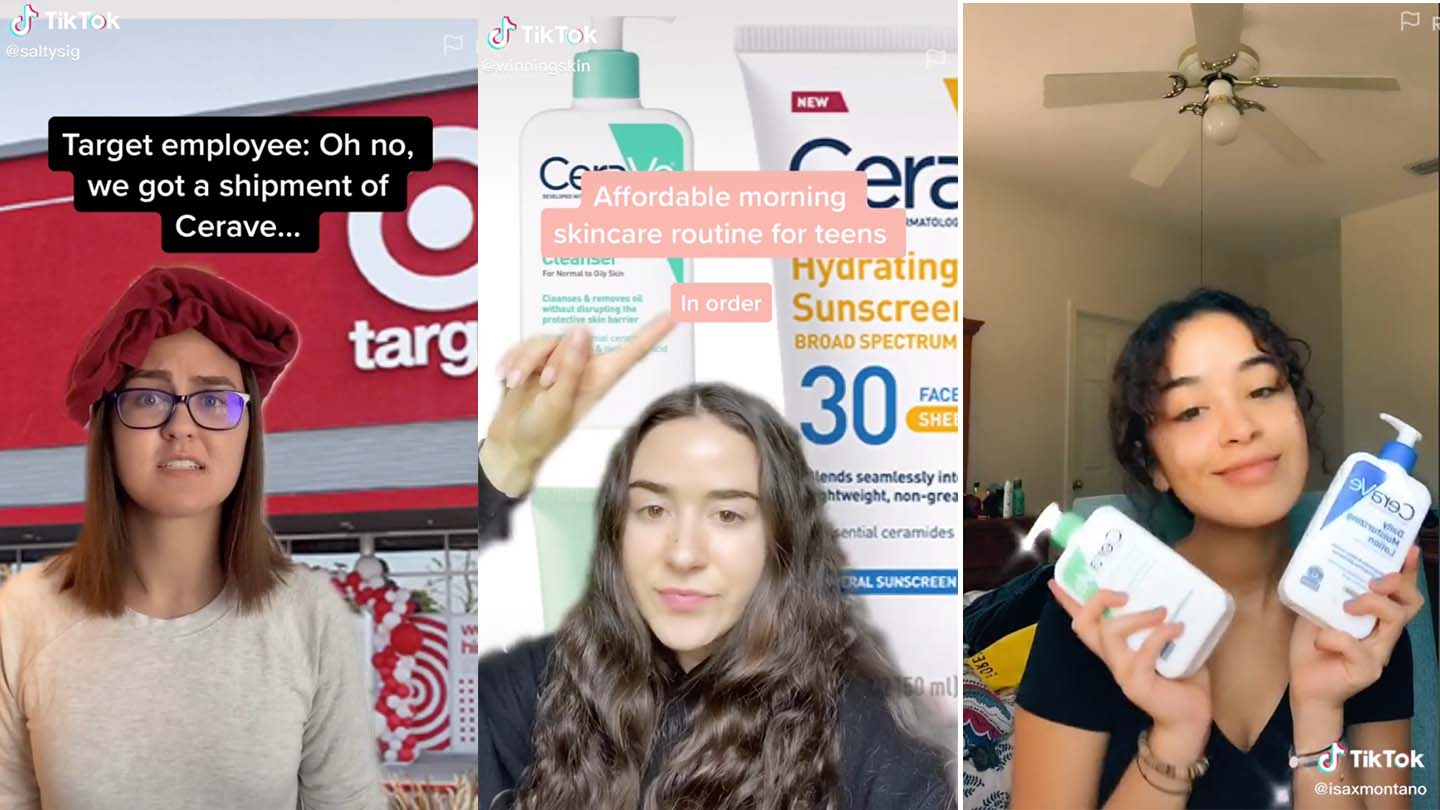With 12.6 billion views, #skincare is having a moment on TikTok and its holy grail find seems to be CeraVe’s range of skincare products.
Since May, long-time users of CeraVe have taken to Twitter to complain about their favourite products being sold out at retailers across the US and UK. Superdrug, the UK health and beauty chain, reported a 65% week on week increase in sales of CeraVe products in June. “Mentions of the brand have increased by 100% from May to July, on our community platform,” says a Superdrug spokesperson.
Despite the pandemic, in the first-quarter sales figures for 2020, L’Oréal –CeraVe’s parent company – reported an over 40% growth in its Active Cosmetics Division driven by its brands like CeraVe. One of the reasons cited for this was the fact that drugstores and pharmacies, where these products are primarily sold, remained open throughout the lockdowns. “The recent buzz on TikTok has helped expand awareness of CeraVe, especially among Gen Z,” says the brand’s co-founder Tom Allison.
But why the sudden hype for a nearly 15-year-old brand? The answer to that – like any odd cultural mystery these days – is TikTok, of course. In the past, people were typically introduced to CeraVe by their dermatologists but the internet, and Gen Z in particular, seem to be discovering it through their new trusted source of information.
“Apart from CeraVe’s moisturisers, they also have a salicylic acid cleanser that I’ve recommended to my patients for acne or rough skin,” says Angelo Landriscina MD, a New York-based dermatologist. On his TikTok @dermangelo, he demystifies skincare for his 126.4K followers but his most popular video isn’t where he breaks down how to interpret a sunscreen label or the horrors of apricot scrubs. It’s a clip of him reacting to a TikToker’s skin transformation after using CeraVe, with two million views.
All fingers point to skincare influencer Hyram Yarbro for driving this newfound obsession for CeraVe. “I usually look at influencer recommendations because some of the hyped products on TikTok are shit,” says Marissa Belle, 26, who bought CeraVe’s foaming cleanser and AM lotion after seeing the hype on TikTok. 21-year-old Amanda had only used the CeraVe moisturiser before @skincarebyhyram recommended it. “A lot of people were tagging him in their skincare videos, so I decided to check out their other products,” she says. 20-year old Yewande Famutimi was also introduced to CeraVe by @skincarebyhyram and “all of the positive reviews” on TikTok.
“I think what’s happened is that people have caught on to the quality for the price,” says Landriscina. “There’s been a shift within the social media skincare sphere where people are looking for effective products that you don’t have to spend a fortune on.”
Another factor seems to be the brand’s accessibility. “Unlike The Ordinary which has to be bought online, CeraVe is a drugstore brand. It’s peak accessible,” says skincare influencer and co-founder of cannabinoid skincare line Dieux, Charlotte Palermino. But she thinks the perception that all skincare should be cheaper could be harmful. “Not every brand has those economies of scale and if you invest in more potent ingredients or new research on new ingredients, then don’t expect your face cream to be $15.”
Charlotte has even gotten a lot of heat from TikTokers for recommending more expensive products. ”I don’t know how to tell them my favourite serum is $80. If your product is from an indie brand, is female or BIPOC founded – meaning it’s less likely to get investment and hence must bootstrap – and makes sophisticated products, it’s going to cost more,” she says. “At the end of the day, indie brands are expected to be sustainable, but beauty giants like L’Oréal set the stage.”
However, like a lot of internet fads – remember Dalgona coffee and pancake cereal? – one size doesn’t fit all, and success isn’t necessarily guaranteed, especially when it comes to something as subjective as skincare. Charlotte cautions people against assuming an influencer’s skin type to be similar to their own. “I’ve had a lot of people tell me they used something an influencer recommended and it made their skin worse,” she says.
Also, TikTok can get a tad overenthusiastic like it did with @zofie_cocol’s video with over two million likes, showing her go from acne-riddled to clear skin “literally after three days” from using CeraVe (she later clarified the transformation took a week). To Angelo, these are red flags for questionable skincare information that TikTok is rife with. “It’s a physiologic impossibility. There is no way that could happen even if you suddenly got on the right regimen. Nothing works in three days,” he says. “People should be wary of anything that claims to turn their skin around within days. That doesn’t exist. You need to give at least six weeks to begin to see the effect of a product.”
Skincare TikTok is an endless rabbit hole that once you enter, it’s impossible to come out without a few of its favourite products and (hopefully) glowing skin. But for this particular trend, you might have to get in line first…


